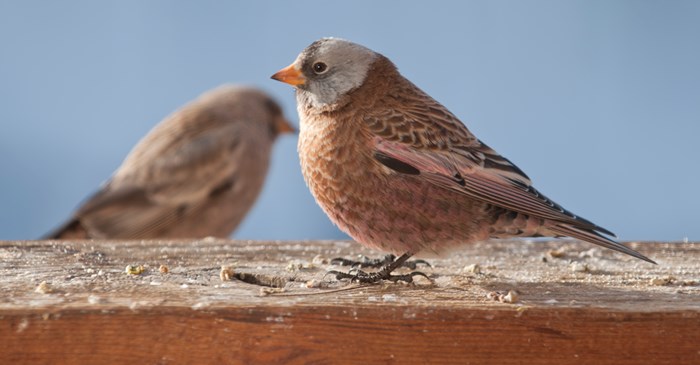Out west, birders keep their eyes peeled on barren mountaintops for a rarest sign of avian life, the Gray-crowned Rosy-Finch.
These tough-as-nails birds nest in the most unlikely of places: on mountaintops, cliff tops and rock piles in pockets of the mountain west, as well as British Columbia and Alaska. Very few scientists have seen the nest of the Gray-crowned Rosy-Finch because they’re so difficult to find and access — it would require mountaineering equipment to get a good look inside the rock opening.
The Gray-crowned Rosy-Finch has a charming homespun look, as if it were designed by a quilter. Their backs are covered with milk-chocolate colored feathers with a subtle white, scallop-like design. Their wings, bellies and rumps are tinted in pink that is striking against the snowy and rocky landscapes.
Getting a positive ID on the Gray-crowned Rosy-Finch can be tricky because they share many physical traits with the Brown-capped Rosy-Finch and the Black Rosy-Finch. In fact, from 1983 until 1998, the three species were classified as one, the Rosy-Finch.
Scientists believe there are at least six subspecies of the Gray-crowned Rosy-Finch, with variations in size, shadings and amount of gray on their heads. Two subspecies that live year-round on Alaska’s Pribilof and Aleutian islands weigh twice as much as their counterparts.
These social birds come from hardy stock. They gather in loose flocks year-round, even at the peak of breeding season, with winter flocks reaching as many as 100 birds. With their long wings, they’ll fly willingly in windy and blizzard conditions. Despite their penchant for extreme and remote environments, they’re not shy around humans. They’ve surprised birders with their willingness to forage up close.
They spend their winters in lower altitudes, in mountain meadows, shrublands, towns, farm and ranch lands, hills and along road ditches. They are also frequent feeder visitors. Fill a tube feeder with Lyric Finch Mix, and they’ll flock in for the Nyjer and sunflower seeds.
